The Compound Effects of Highway Reconstruction and Climate Change on Vegetation Activity over the Qinghai Tibet Plateau: The G318 Highway as a Case Study
Abstract
:1. Introduction
2. Materials and Methods
2.1. Study Area
2.2. Datasets
2.3. Methods
2.3.1. Trend Analyses
2.3.2. Quantitative Modeling of the Impacts of Climatic and Reconstruction Forces
2.3.3. Relationships between Climatic Factors and Vegetation Activity
3. Results
3.1. Spatiotemporal Changes in Vegetation Activity
3.1.1. Trends and Interannual Variation in the Growing-Season EVI
3.1.2. Spatial Variation of the EVI
3.2. Impacts of Climate Change and Reconstruction on Vegetation Activity
3.3. Response of Vegetation Activity to Climate Change and Lag Time
3.3.1. The Effects of Climate Factors on the Vegetation Variation
3.3.2. The Lagging Effect of Vegetation Activity on Climate Change
4. Discussion
4.1. Regional Vegetation Changes and Anthropogenic Forces
4.2. Relationships between Climate Factors and Vegetation Variation
4.3. Uncertainties
5. Conclusions
Author Contributions
Funding
Data Availability Statement
Conflicts of Interest
Appendix A
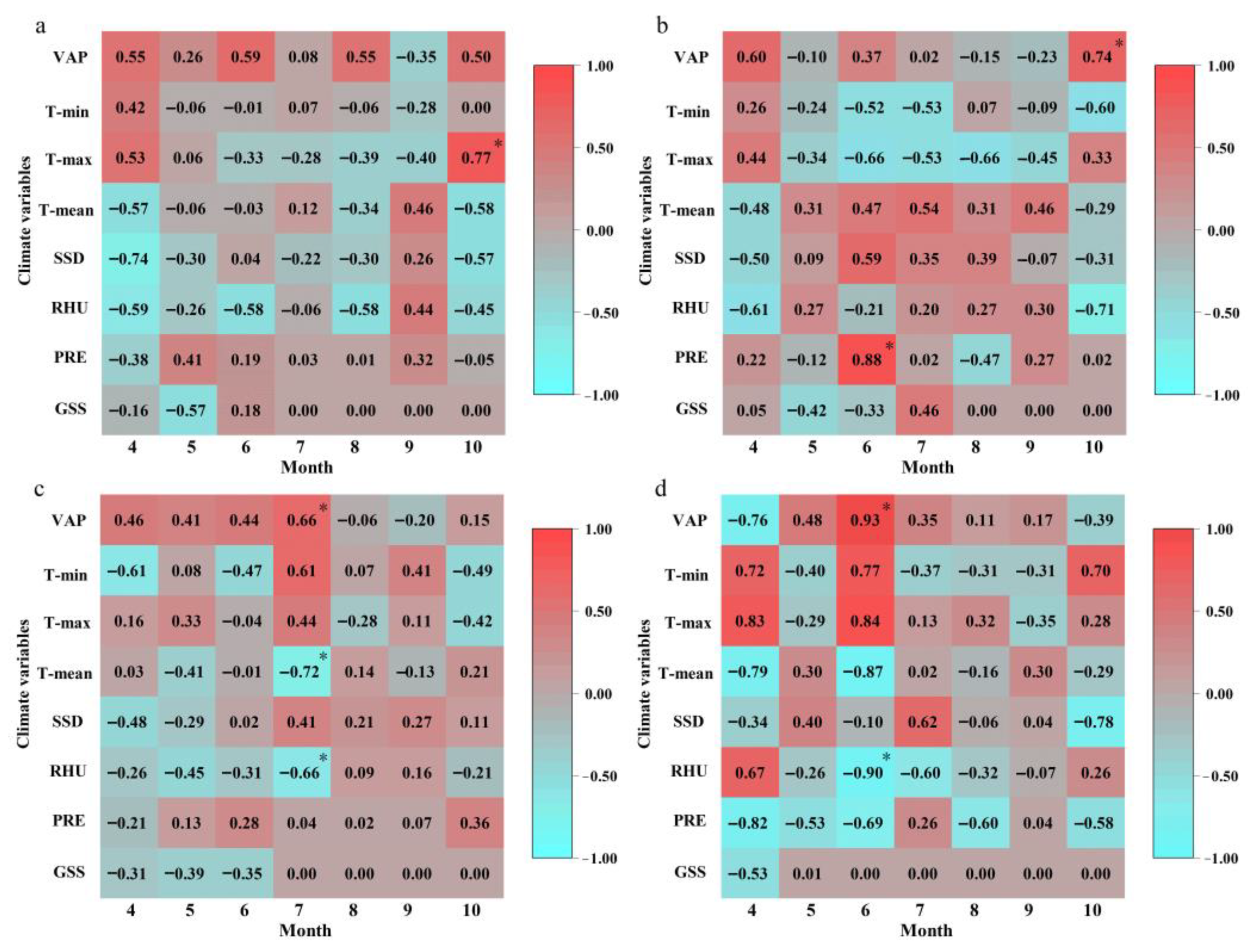
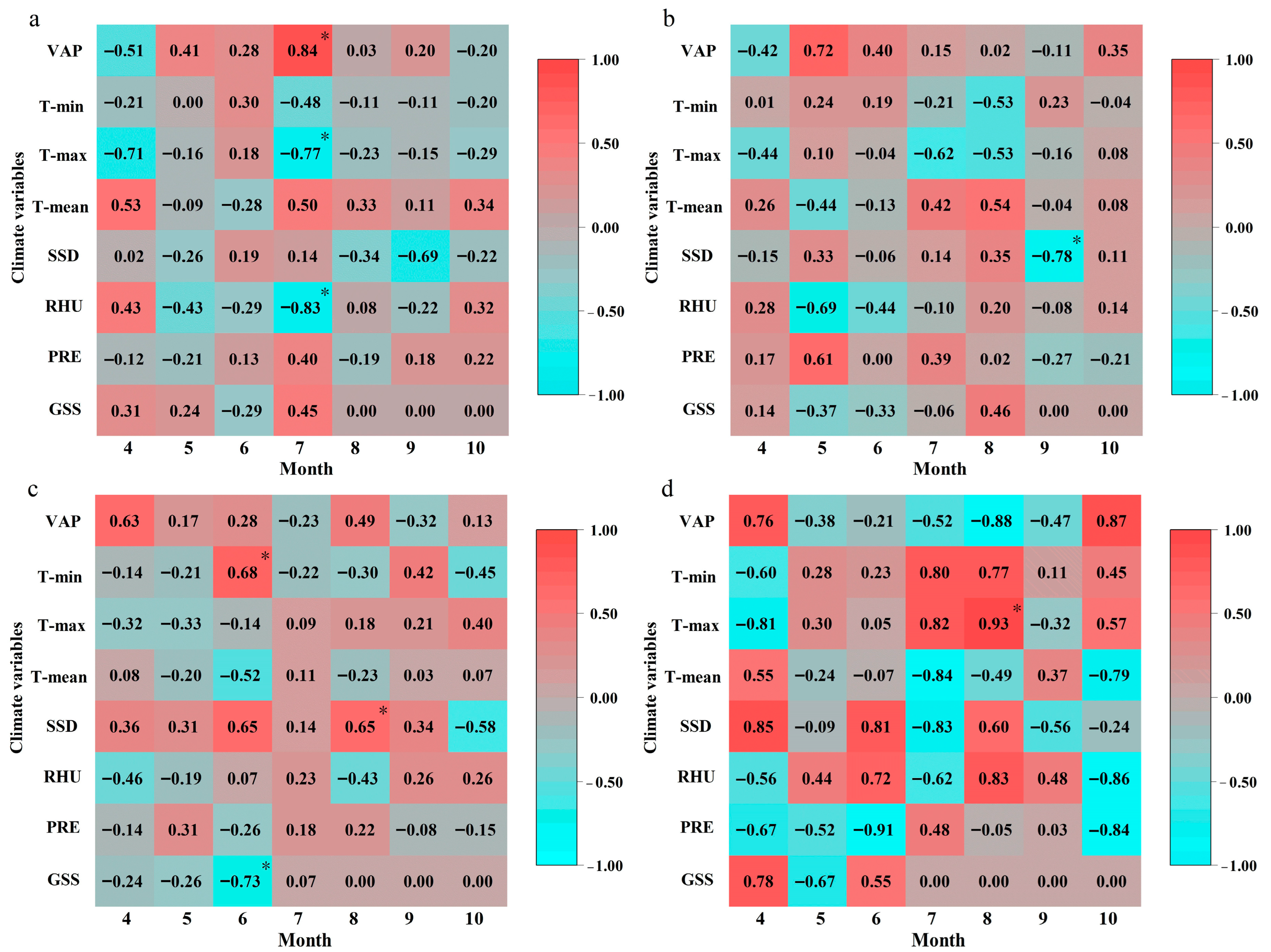

| Factors | Definition | Abbreviations |
|---|---|---|
| Roads | West of Shigatse | WS |
| Shigatse to Lhasa | SL | |
| Lhasa to Nyingchi | LN | |
| East of Nyingchi | NE | |
| The Tibetan section of the G318 national highway | TG318 | |
| Climate factors | Monthly snow cover | GSS |
| Precipitation | PRE | |
| Relative humidity | RHU | |
| Sunshine duration | SSD | |
| Mean temperature | T-mean | |
| Maximum temperature | T-max | |
| Minimum temperature | T-min | |
| Vapor pressure | VAP | |
| Vegetation index | The Moderate Resolution Imaging Spectroradiometer Enhanced Vegetation Index | MODIS EVI |
| Buffer zone | Core area | C |
| Background area | B |
References
- Kang, S.; Zhang, Y.; Chen, P.; Guo, J.; Zhang, Q.; Cong, Z.; Kaspari, S.; Tripathee, L.; Gao, T.; Niu, H.; et al. Black carbon and organic carbon dataset over the Third Pole. Earth Syst. Sci. Data 2022, 14, 683–707. [Google Scholar] [CrossRef]
- Yao, T.; Bolch, T.; Chen, D.; Gao, J.; Immerzeel, W.; Piao, S.; Su, F.; Thompson, L.; Wada, Y.; Wang, L.; et al. The imbalance of the Asian water tower. Nat. Rev. Earth Environ. 2022, 3, 618–632. [Google Scholar] [CrossRef]
- Fang, C. Special thinking and green development path of urbanization in Qinghai-Tibet Plateau. Acta Geogr. Sin. 2022, 77, 1907–1919. (In Chinese) [Google Scholar]
- Fu, B.; Ouyang, Z.; Shi, P.; Fan, J.; Wang, X.; Zheng, H.; Zhao, W.; Wu, F. Current Condition and Protection Strategies of Qinghai-Tibet Plateau Ecological Security Barrier. Bull. Chin. Acad. Sci. 2021, 36, 1298–1306. (In Chinese) [Google Scholar]
- Jiang, W.; Lu, Y.; Liu, Y.; Gao, W. Ecosystem service value of the Qinghai-Tibet Plateau significantly increased during 25 years. Ecosyst. Serv. 2020, 44, 101146. [Google Scholar] [CrossRef]
- Shen, M.; Piao, S.; Chen, X.; An, S.; Fu, Y.S.; Wang, S.; Cong, N.; Janssens, I.A. Strong impacts of daily minimum temperature on the green-up date and summer greenness of the Tibetan Plateau. Glob. Chang. Biol. 2016, 22, 3057–3066. [Google Scholar] [CrossRef] [PubMed]
- Wang, Y.; Lv, W.; Xue, K.; Wang, S.; Zhang, L.; Hu, R.; Zeng, H.; Xu, X.; Li, Y.; Jiang, L.; et al. Grassland changes and adaptive management on the Qinghai–Tibetan Plateau. Nat. Rev. Earth Environ. 2022, 3, 668–683. [Google Scholar] [CrossRef]
- Kuang, X.; Jiao, J. Review on climate change on the Tibetan Plateau during the last half century. J. Geophys. Res. Atmos. 2016, 121, 3979–4007. [Google Scholar] [CrossRef]
- Zhang, D.; Huang, J.; Guan, X.; Chen, B.; Zhang, L. Long-term trends of precipitable water and precipitation over the Tibetan Plateau derived from satellite and surface measurements. J. Quant. Spectrosc. Radiat. Transf. 2013, 122, 64–71. [Google Scholar] [CrossRef]
- Cai, D.; You, Q.; Fraedrich, K.; Guan, Y. Spatiotemporal Temperature Variability over the Tibetan Plateau: Altitudinal Dependence Associated with the Global Warming Hiatus. J. Clim. 2017, 30, 969–984. [Google Scholar] [CrossRef]
- Hua, S.; Liu, Y.; Jia, R.; Chang, S.; Wu, C.; Zhu, Q.; Shao, T.; Wang, B. Role of clouds in accelerating cold-season warming during 2000–2015 over the Tibetan Plateau. Int. J. Climatol. 2018, 38, 4950–4966. [Google Scholar] [CrossRef]
- Ma, S.; Wang, L.; Jiang, J.; Chu, L.; Zhang, J. Threshold effect of ecosystem services in response to climate change and vegetation coverage change in the Qinghai-Tibet Plateau ecological shelter. J. Clean. Prod. 2021, 318, 128592. [Google Scholar] [CrossRef]
- Chen, D.; Xu, B.; Yao, T.; Guo, Z.; Cui, P.; Chen, F.; Zhang, R.; Zhang, X.; Zhang, Y.; Fan, J.; et al. Assessment of past, present and future environmental changes on the Tibetan Plateau. Chin. Sci. Bull. 2015, 60, 3025–3035. (In Chinese) [Google Scholar]
- Liu, X.; Cheng, Z.; Zhang, R. The A1B scenario projection for climate change over the Tibetan Plateau in the next 30–50 years. Plateau Meteorol. 2009, 28, 475–484. (In Chinese) [Google Scholar]
- Zhou, M.; Yu, Z.; Gu, H.; Ju, Q.; Gao, Y.; Wen, L.; Huang, T.; Wang, W. Evaluation and projections of surface air temperature over the Tibetan Plateau from CMIP6 and CMIP5: Warming trend and uncertainty. Clim. Dyn. 2023, 60, 3863–3883. [Google Scholar] [CrossRef]
- Lin, J.; Zhang, J.; Lv, Q.; Liu, H.; Liu, Y. How Transport Has Changed on the Snowy Plateau over the Past Decade. China’s Tibet 2022, 33, 4–13. [Google Scholar]
- Zhang, J.; Yuan, M.; Zhang, J.; Li, H.; Wang, J.; Zhang, X.; Ju, P.; Jiang, H.; Chen, H.; Zhu, Q. Responses of the NDVI of alpine grasslands on the Qinghai-Tibetan Plateau to climate change and human activities over the last 30 years. Acta Ecol. Sin. 2020, 40, 6269–6281. (In Chinese) [Google Scholar]
- Ge, W.; Deng, L.; Wang, F.; Han, J. Quantifying the contributions of human activities and climate change to vegetation net primary productivity dynamics in China from 2001 to 2016. Sci. Total Environ. 2021, 773, 145648. [Google Scholar] [CrossRef]
- Banerjee, A.; Kang, S.; Meadows, M.E.; Xia, Z.; Sengupta, D.; Kumar, V. Quantifying climate variability and regional anthropogenic influence on vegetation dynamics in northwest India. Environ. Res. 2023, 234, 116541. [Google Scholar] [CrossRef]
- Zhao, L.; Dai, A.; Dong, B. Changes in global vegetation activity and its driving factors during 1982–2013. Agric. For. Meteorol. 2018, 249, 198–209. [Google Scholar] [CrossRef]
- Xu, H.; Wang, X.; Zhang, X. Alpine grasslands response to climatic factors and anthropogenic activities on the Tibetan Plateau from 2000 to 2012. Ecol. Eng. 2016, 92, 251–259. [Google Scholar] [CrossRef]
- Zhang, Q.; Yuan, R.; Singh, V.P.; Xu, C.; Fan, K.; Shen, Z.; Wang, G.; Zhao, J. Dynamic vulnerability of ecological systems to climate changes across the Qinghai-Tibet Plateau. China Ecol. Indic. 2022, 134, 108483. [Google Scholar] [CrossRef]
- Li, S.; Wu, J.; Gong, J.; Li, S. Human footprint in Tibet: Assessing the spatial layout and effectiveness of nature reserves. Sci. Total Environ. 2018, 621, 18–29. [Google Scholar] [CrossRef] [PubMed]
- Wei, Y.; Lu, H.; Wang, J.; Wang, X.; Sun, J. Dual influence of climate change and anthropogenic activities on the spatiotemporal vegetation dynamics over the Qinghai-Tibetan Plateau from 1981 to 2015. Earth’s Future 2022, 10, e2021EF002566. [Google Scholar] [CrossRef]
- Zhu, B.; Zhang, Z.; Tian, J.; Kong, R.; Chen, X. Increasing Negative Impacts of Climatic Change and Anthropogenic Activities on Vegetation Variation on the Qinghai–Tibet Plateau during 1982–2019. Remote Sens. 2022, 14, 4735. [Google Scholar] [CrossRef]
- Ma, C.; Li, T.; Liu, P. GIMMS NDVI3g+ (1982–2015) response to climate change and engineering activities along the Qinghai–Tibet Railway. Ecol. Indic. 2021, 128, 107821. [Google Scholar] [CrossRef]
- Cong, N.; Shen, M.; Yang, W.; Yang, Z.; Zhang, G.; Piao, S. Varying responses of vegetation activity to climate changes on the Tibetan Plateau grassland. Int. J. Biometeorol. 2017, 61, 1433–1444. [Google Scholar] [CrossRef] [PubMed]
- Lian, X.; Piao, S.; Chen, A.; Wang, K.; Li, X.; Buermann, W.; Huntingford, C.; Penuelas, J.; Xu, H.; Myneni, R.B. Seasonal biological carryover dominates northern vegetation growth. Nat. Commun. 2021, 12, 983. [Google Scholar] [CrossRef]
- Sun, Y.; Liu, S.; Liu, Y.; Dong, Y.; Li, M.; An, Y.; Shi, F.; Beazley, R. Effects of the interaction among climate, terrain and human activities on biodiversity on the Qinghai-Tibet Plateau. Sci. Total Environ. 2021, 794, 148497. [Google Scholar] [CrossRef]
- Ye, C.; Wei, R.; Ge, Y.; Li, Y.; Marcato, J.; Li, J. GIS-based spatial prediction of landslide using road factors and random forest for Sichuan-Tibet Highway. J. Mt. Sci. 2022, 19, 461–476. [Google Scholar] [CrossRef]
- Tao, T.; Zhang, X. Difficulties and strategies of G318 extension and reconstruction design in Tibet. Shanxi Arch. 2014, 40, 145–146. (In Chinese) [Google Scholar]
- Jiang, G.; Zhao, H.; Liu, Y.; Wu, Q.; Gao, S. Discrepancies of permafrost variations under thermal impacts from highway and railway on the Qinghai-Tibet Plateau. Cold Reg. Sci. Technol. 2023, 208, 103784. [Google Scholar] [CrossRef]
- Zhang, Z.; Wu, Q.; Liu, Y.; Wen, Z. Analysis on hydrothermal difference changes of highway pavement structure on the Qinghai-Tibet Plateau. J. Southeast Univ. Nat. Sci. Ed. 2015, 45, 975–979. (In Chinese) [Google Scholar]
- Cai, B.; Lu, R. Application of RS and GIS to road ecological effect assessment. J. Chang’an Univ. Nat. Sci. Ed. 2009, 29, 54–58. (In Chinese) [Google Scholar]
- Liang, K.; Zhang, G.; Li, H.; Wen, J. The road-region boundary based on vegetation index. Acta Sci. Nat. Univ. Sunyatseni 2020, 59, 101–109. (In Chinese) [Google Scholar]
- Li, W.; Qin, Z.; Li, W.; Yang, Q. Comparison and analysis of MODIS NDVI and MODIS EVI. Remote Sens. Inf. 2010, 2010, 73–78. (In Chinese) [Google Scholar]
- Zhang, Y.; Wang, J.; Nong, L.; Cheng, F.; Zhang, Y. Spatio-temporal variation of vegetation phenology and its response to climate in the tropic of cancer (Yunnan section) based on MODIS time-series data. Ecol. Environ. Sci. 2021, 30, 274–287. (In Chinese) [Google Scholar]
- Zhang, G.; Zhang, Y.; Dong, J.; Xiao, X. Green-up dates in the Tibetan Plateau have continuously advanced from 1982 to 2011. Proc. Natl. Acad. Sci. USA 2013, 110, 4309–4314. [Google Scholar] [CrossRef]
- Gu, Y.; Pang, B.; Qiao, X.; Xu, D.; Li, W.; Yan, Y.; Dou, H.; Ao, W.; Wang, W.; Zou, C.; et al. Vegetation dynamics in response to climate change and human activities in the Hulun Lake basin from 1981 to 2019. Ecol. Indic. 2022, 136, 108700. [Google Scholar] [CrossRef]
- Wang, X.; Zhu, J.; Peng, S.; Zheng, T.; Qi, Z.; Hu, J.; Ji, C. Patterns of grassland community composition and structure along an elevational gradient on the Qinghai-Tibet Plateau. J. Plant Ecol. 2022, 15, 808–817. [Google Scholar] [CrossRef]
- Zhang, L.; Wang, J.; Zhao, R.; Guo, Y.; Hao, L.; Hu, Z. Aboveground net primary productivity and soil respiration display different responses to precipitation changes in desert grassland. J. Plant Ecol. 2022, 15, 57–70. [Google Scholar] [CrossRef]
- Dai, Y.; Gong, F.; Yang, X.; Chen, X.; Su, Y.; Liu, L.; Wu, J.; Liu, X.; Sun, Q. Litterfall seasonality and adaptive strategies of tropical and subtropical evergreen forests in China. J. Plant Ecol. 2022, 15, 320–334. [Google Scholar] [CrossRef]
- Sun, Y.; Shan, M.; Pei, X.; Zhang, X.; Yang, Y. Assessment of the impacts of climate change and human activities on vegetation cover change in the Haihe River basin, China. Phys. Chem. Earth 2020, 115, 102834. [Google Scholar] [CrossRef]
- Zhang, G.; Xu, X.; Zhou, C.; Zhang, H.; Ouyang, H. Responses of grassland vegetation to climatic variations on different temporal scales in Hulun Buir Grassland in the past 30 years. J. Geogr. Sci. 2011, 21, 634–650. [Google Scholar] [CrossRef]
- Wang, L.; Wei, X.; Zhang, Z.; Guo, Z.; Huang, S. NDVI variation and its relationship with temperature and precipitation on the Tibetan Plateau. J. For. Environ. 2022, 42, 141–148. (In Chinese) [Google Scholar]
- Yang, C.; Wang, S.; Yang, C.; Feng, C.; Gao, Y.; Sun, Q. Spatial-temporal variation characteristics of vegetation coverage along Sichuan-Tibet railway. J. Arid Land Resour. Environ. 2021, 35, 174–182. (In Chinese) [Google Scholar]
- Pan, Y.; Wang, Y.; Zheng, S.; Huete, A.R.; Shen, M.; Zhang, X.; Huang, J.; He, G.; Yu, L.; Xu, X.; et al. Characteristics of Greening along Altitudinal Gradients on the Qinghai-Tibet Plateau Based on Time-Series Landsat Images. Remote Sens. 2022, 14, 2408. [Google Scholar] [CrossRef]
- Zhang, X.; Wang, J.; Gao, Y.; Wang, L. Variations and controlling factors of vegetation dynamics on the Qingzang Plateau of China over the recent 20 years. Geogr. Sustain. 2021, 2, 74–85. [Google Scholar] [CrossRef]
- Song, Y.; Jin, L.; Chen, J. Study of the vegetation change due to the reinforcement and rebuilding along the Qinghai-Tibet Highway. J. Glaciol. Geocryol. 2014, 36, 1017–1025. (In Chinese) [Google Scholar]
- Zhou, D.; Fan, G.; Huang, R.; Fang, Z.; Liu, Y.; Li, H. Interannual variability of the normalized difference vegetation index on the Tibetan plateau and its relationship with climate change. Adv. Atmos. Sci. 2007, 24, 474–484. [Google Scholar] [CrossRef]
- Yang, H.; Xu, Y.; Wang, L.; Xu, L. Spatio-temporal variation of human activity intensity and its driving factors on the Qinghai-Tibet Plateau. Acta Ecol. Sin. 2023, 43, 3995–4009. (In Chinese) [Google Scholar]
- Li, Q.; Zhang, C.; Shen, Y.; Jia, W.; Li, J. Quantitative assessment of the relative roles of climate change and human activities in desertification processes on the Qinghai-Tibet Plateau based on net primary productivity. Catena 2016, 147, 789–796. [Google Scholar] [CrossRef]
- Luo, Z.; Wu, W.; Yu, X.; Song, Q.; Yang, J.; Wu, J.; Zhang, H. Variation of Net Primary Production and Its Correlation with Climate Change and Anthropogenic Activities over the Tibetan Plateau. Remote Sens. 2018, 10, 1352. [Google Scholar] [CrossRef]
- Jin, K.; Wang, F.; Han, J.; Shi, S.; Ding, W. Contribution of climatic change and human activities to vegetation NDVI change over China during 1982–2015. Acta Geogr. Sin. 2020, 75, 961–974. (In Chinese) [Google Scholar]
- Ma, C.; Cui, P.; Zhong, G.; Meng, M.; Yang, C.; Ma, W. Impact of climate change and engineering activities on spatiotemporal changes of vegetation index along Qinghai-Tibet Railway. Geogr. Res. 2021, 40, 35–51. (In Chinese) [Google Scholar]
- Jiang, G.; Wang, L.; Yun, H.; Gao, S.; Wu, Q. Thermal influences of road engineering on permafrost underneath different surface condition in the Qinghai-Tibet Plateau. Cold Reg. Sci. Technol. 2020, 173, 103028. [Google Scholar] [CrossRef]
- Santero, N.J.; Masanet, E.; Horvath, A. Life-cycle assessment of pavements Part II: Filling the research gaps. Resour. Conserv. Recycl. 2011, 55, 810–818. [Google Scholar] [CrossRef]
- Sen, S.; Roesler, J. Aging albedo model for asphalt pavement surfaces. J. Clean. Prod. 2016, 117, 169–175. [Google Scholar] [CrossRef]
- Wu, Q.; Niu, F. Permafrost changes and engineering stability in Qinghai-Xizang Plateau. Chin. Sci. Bull. 2013, 58, 1079–1094. [Google Scholar] [CrossRef]
- Wei, G.; Gao, W.; Dong, N.; Wang, X.; Zeng, M. Test analysis on drainage base mixture of asphalt pavement in cold area. IOP Conf. Ser. Earth Environ. Sci. 2020, 510, 52006. [Google Scholar]
- Ding, M.; Zhang, Y.; Sun, X.; Liu, L.; Wang, Z.; Bai, W. Spatiotemporal variation in alpine grassland phenology in the Qinghai-Tibetan Plateau from 1999 to 2009. Chin. Sci. Bull. 2013, 58, 396–405. [Google Scholar] [CrossRef]
- Yang, Y.; Piao, S. Variations in grassland vegetation cover in relation to climatic factors on the Tibetan Plateau. Chin. J. Plant Ecol. 2006, 30, 1. (In Chinese) [Google Scholar]
- Zhang, Q.; Kong, D.; Shi, P.; Singh, V.P.; Sun, P. Vegetation phenology on the Qinghai-Tibetan Plateau and its response to climate change (1982–2013). Agric. For. Meteorol. 2018, 248, 408–417. [Google Scholar] [CrossRef]
- Jiao, K.; Gao, J.; Liu, Z. Precipitation Drives the NDVI Distribution on the Tibetan Plateau While High Warming Rates May Intensify Its Ecological Droughts. Remote Sens. 2021, 13, 1305. [Google Scholar] [CrossRef]
- Crausbay, S.D.; Ramirez, A.R.; Carter, S.L.; Cross, M.S.; Hall, K.R.; Bathke, D.J.; Betancourt, J.L.; Colt, S.; Cravens, A.E.; Dalton, M.S.; et al. Defining Ecological Drought for the Twenty-First Century. Bull. Am. Meteorol. Soc. 2017, 98, 2543–2550. [Google Scholar] [CrossRef]
- Michaletz, S.T.; Cheng, D.; Kerkhoff, A.J.; Enquist, B.J. Convergence of terrestrial plant production across global climate gradients. Nature 2014, 512, 39–43. [Google Scholar] [CrossRef]
- Liu, X.; Chen, Y.; Li, Z.; Li, Y.; Zhang, Q.; Zan, M. Driving Forces of the Changes in Vegetation Phenology in the Qinghai-Tibet Plateau. Remote Sens. 2021, 13, 4952. [Google Scholar] [CrossRef]
- Yu, H. Dynamics of Grassland Growth and Its Response to Climate Change on Tibetan Plateau. Ph.D. Thesis, Lanzhou University, Lanzhou, China, 2013. (In Chinese). [Google Scholar]
- Guo, L.; Cheng, J.; Luedeling, E.; Koerner, S.E.; He, J.-S.; Xu, J.; Gang, C.; Li, W.; Luo, R.; Peng, C. Critical climate periods for grassland productivity on China’s Loess Plateau. Agric. For. Meteorol. 2017, 233, 101–109. [Google Scholar] [CrossRef]
- Luedeling, E.; Guo, L.; Dai, J.; Leslie, C.; Blanke, M.M. Differential responses of trees to temperature variation during the chilling and forcing phases. Agric. For. Meteorol. 2013, 181, 33–42. [Google Scholar] [CrossRef]
- Xu, L.; Myneni, R.B.; Chapin, F.S.; Callaghan, T.V.; Pinzon, J.E.; Tucker, C.J.; Zhu, Z.; Bi, J.; Ciais, P.; Tommervik, H.; et al. Temperature and vegetation seasonality diminishment over northern lands. Nat. Clim. Chang. 2013, 3, 581–586. [Google Scholar] [CrossRef]
- Shen, M.; Piao, S.; Cong, N.; Zhang, G.; Janssens, I.A. Precipitation impacts on vegetation spring phenology on the Tibetan Plateau. Glob. Chang. Biol. 2015, 21, 3647–3656. [Google Scholar] [CrossRef]
- Knoche, M.; Fischer, C.; Pohl, E.; Krause, P.; Merz, R. Combined uncertainty of hydrological model complexity and satellite-based forcing data evaluated in two data-scarce semi-arid catchments in Ethiopia. J. Hydrol. 2014, 519, 2049–2066. [Google Scholar] [CrossRef]
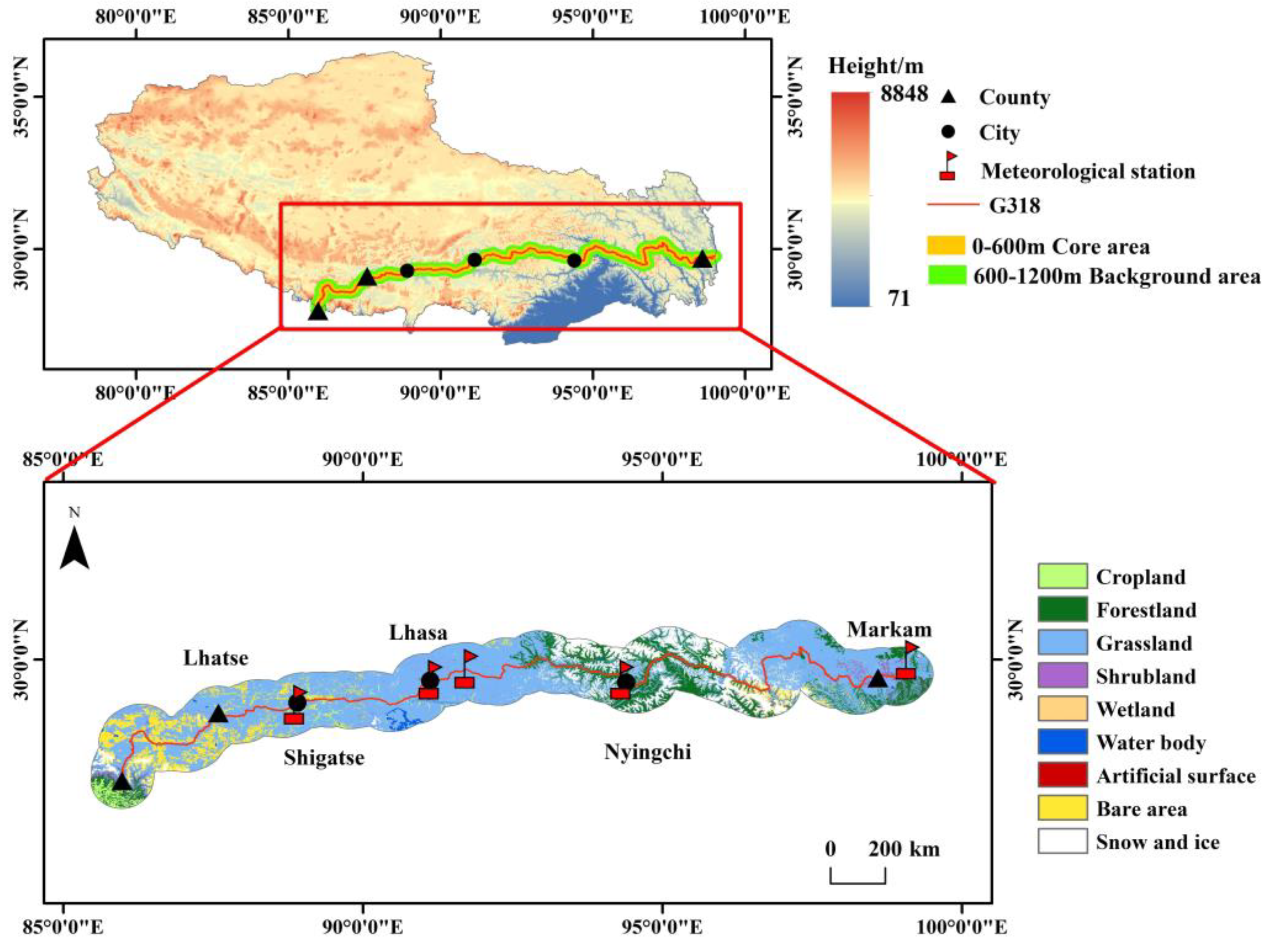
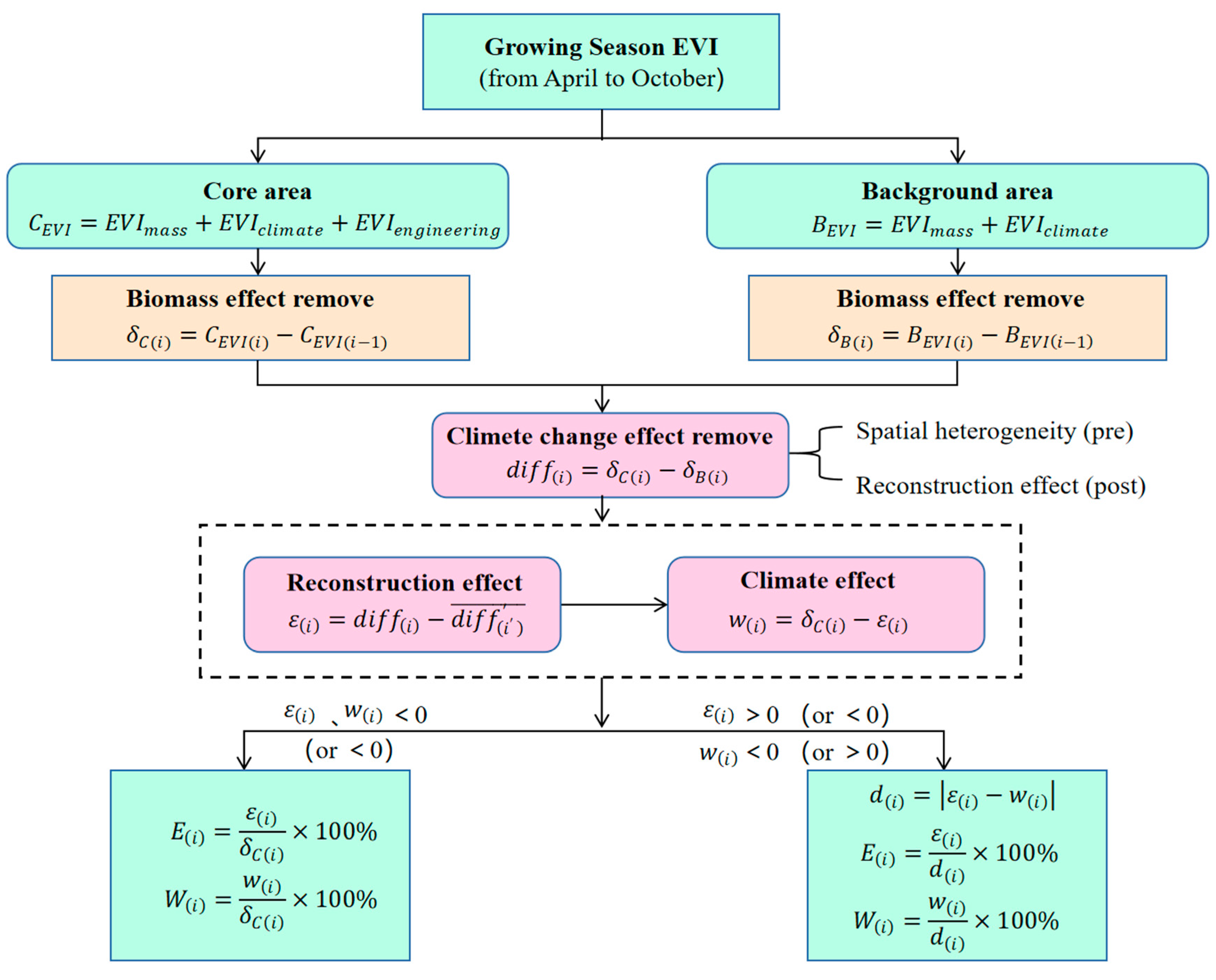
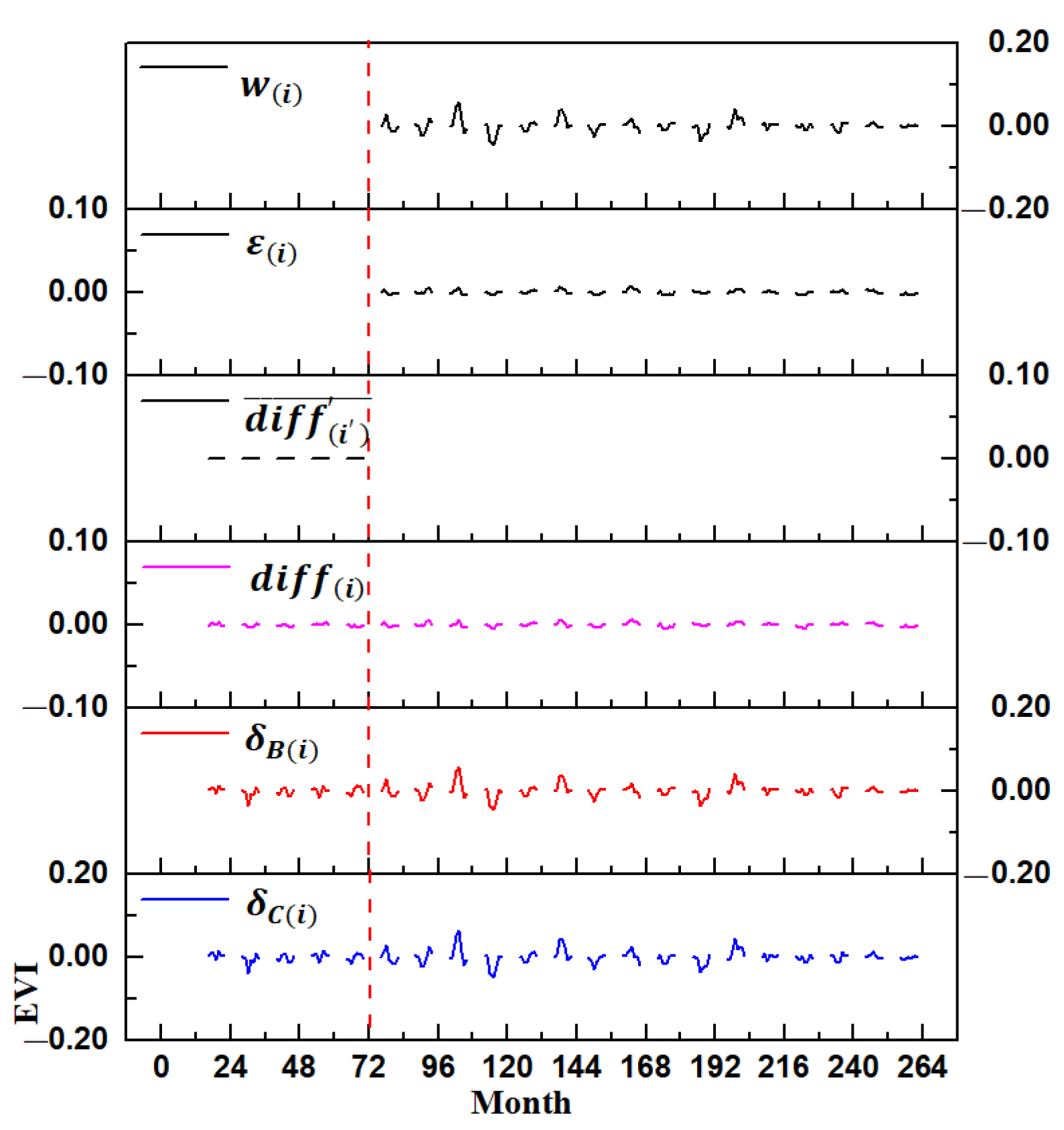
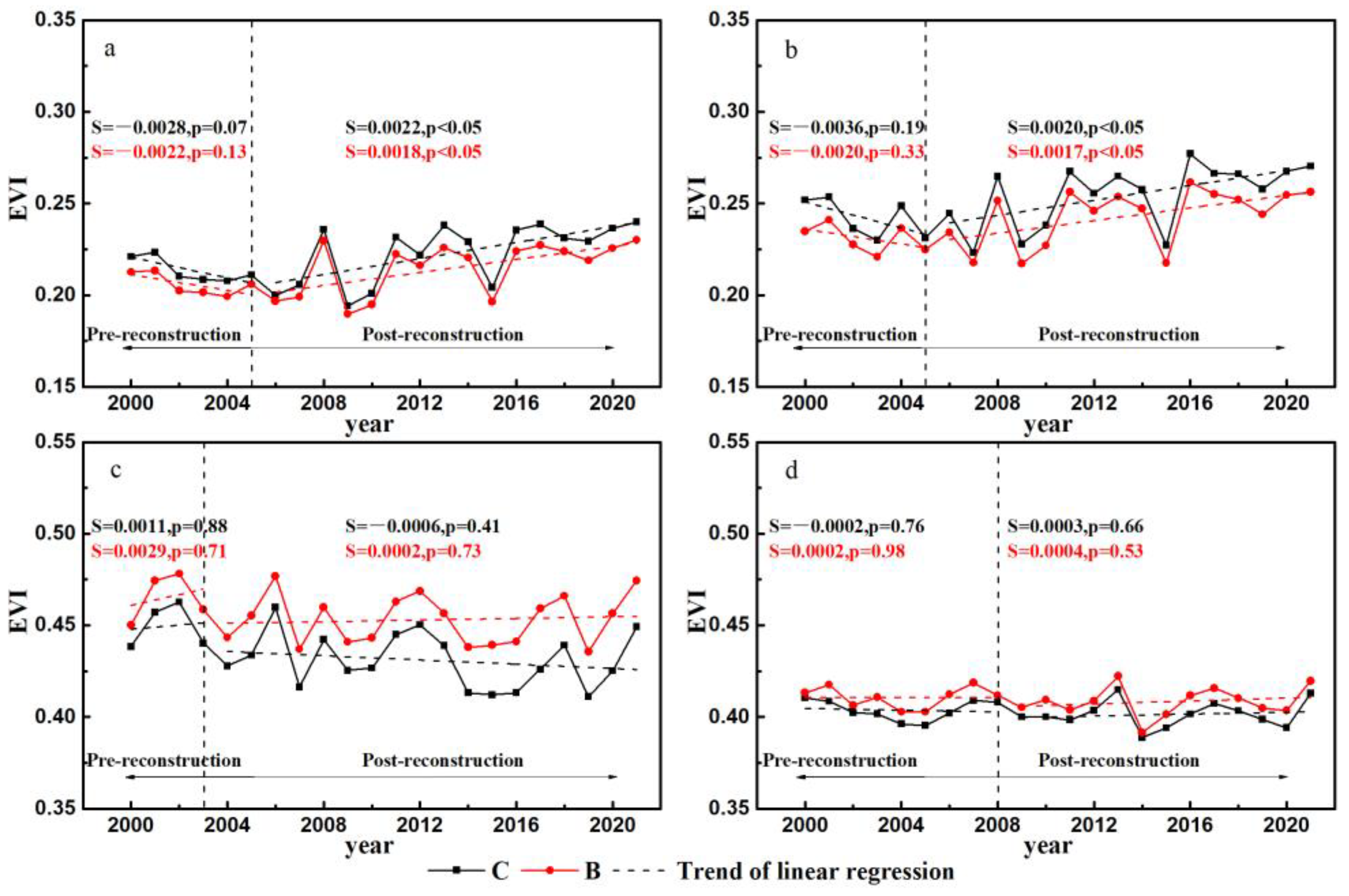
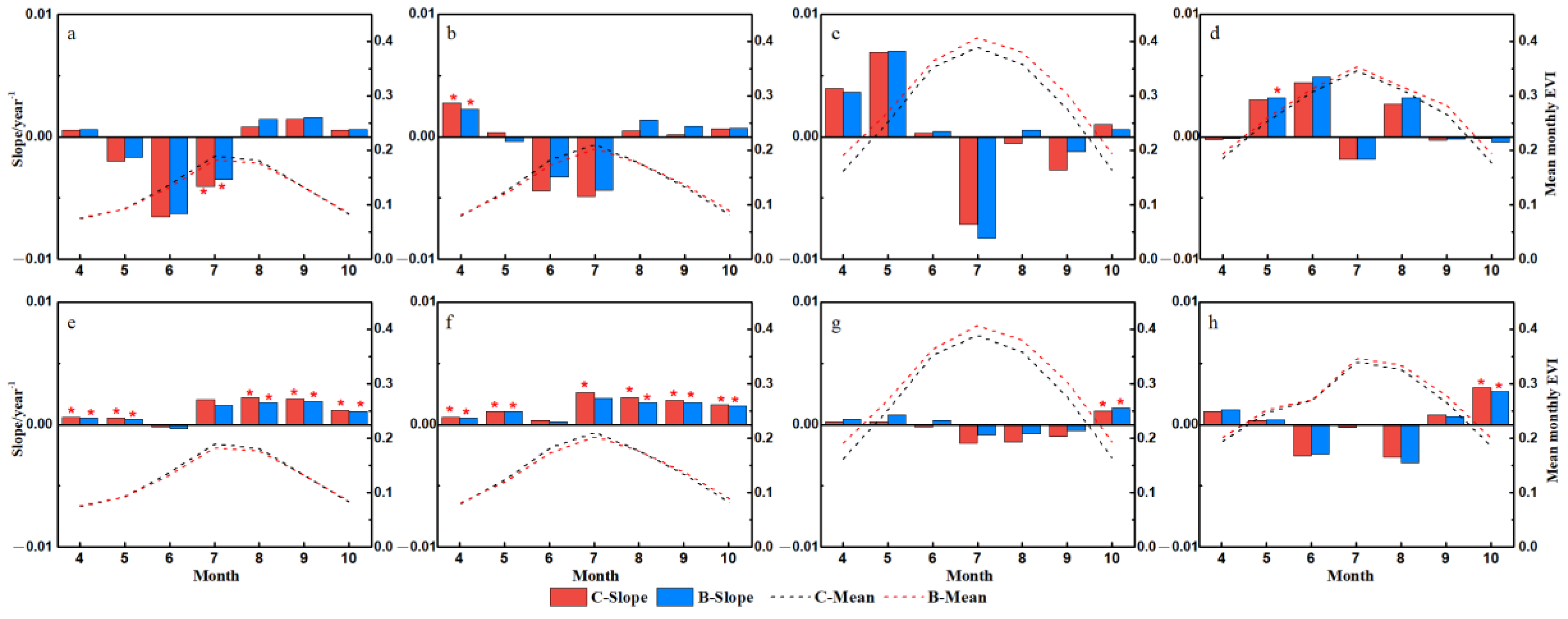
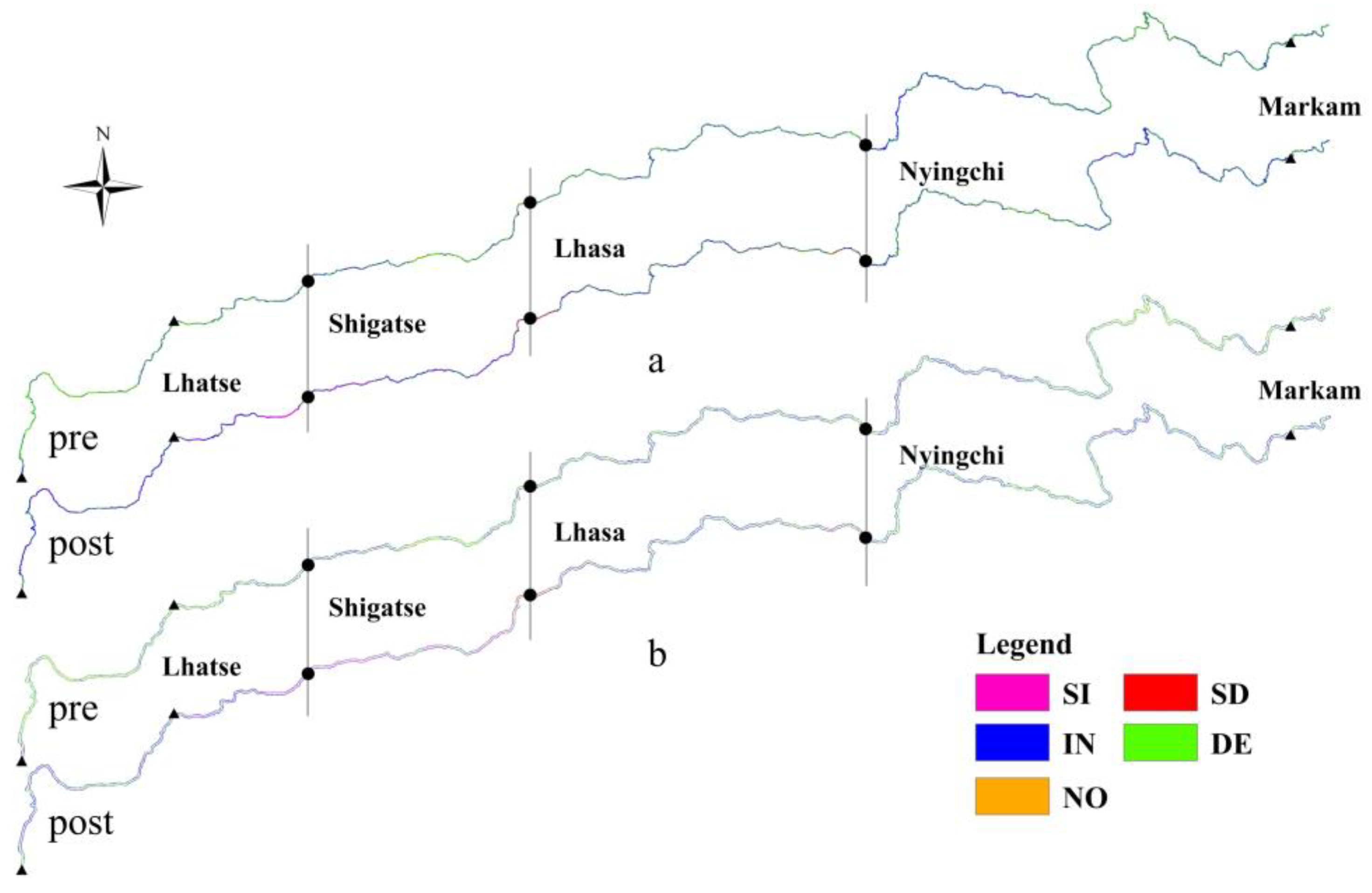
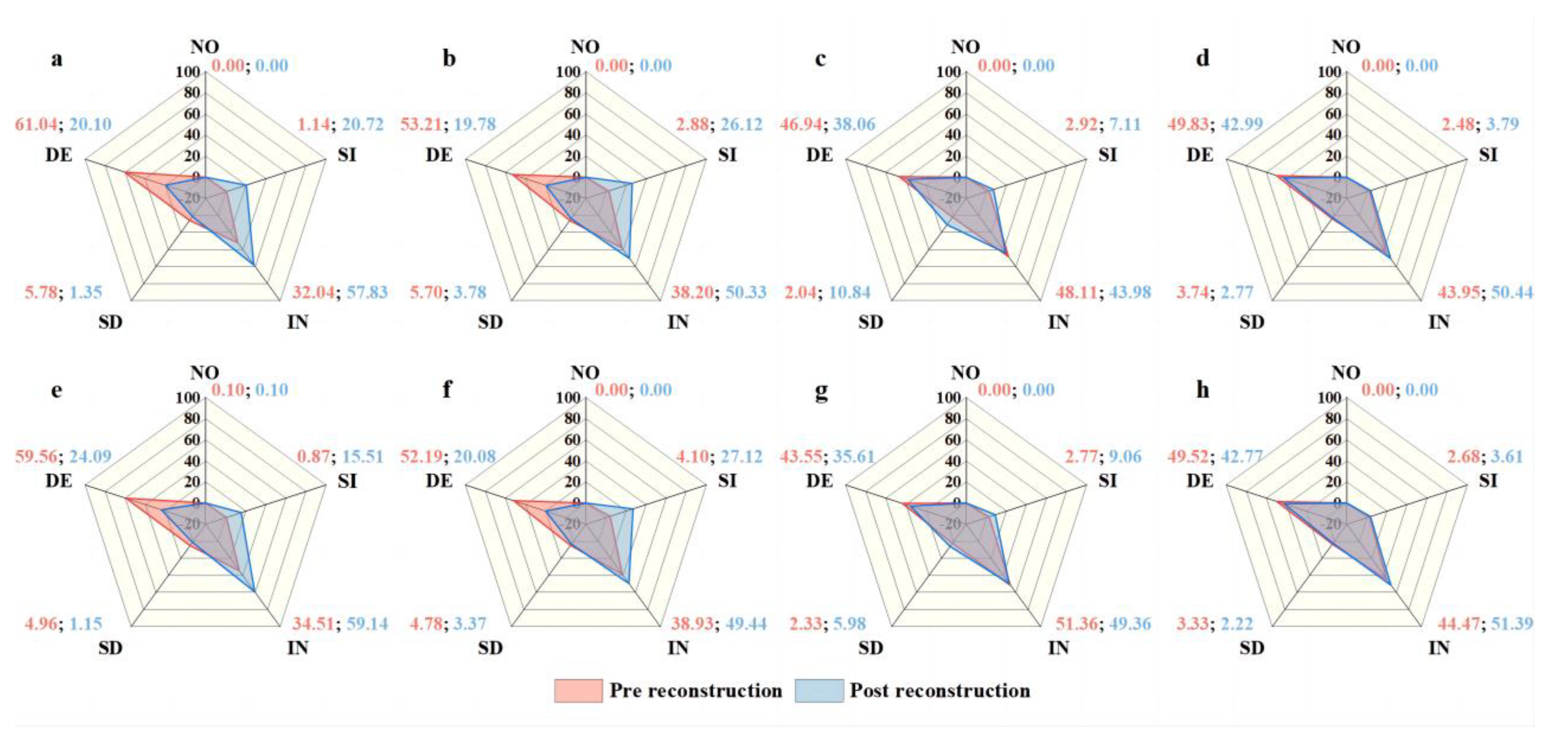
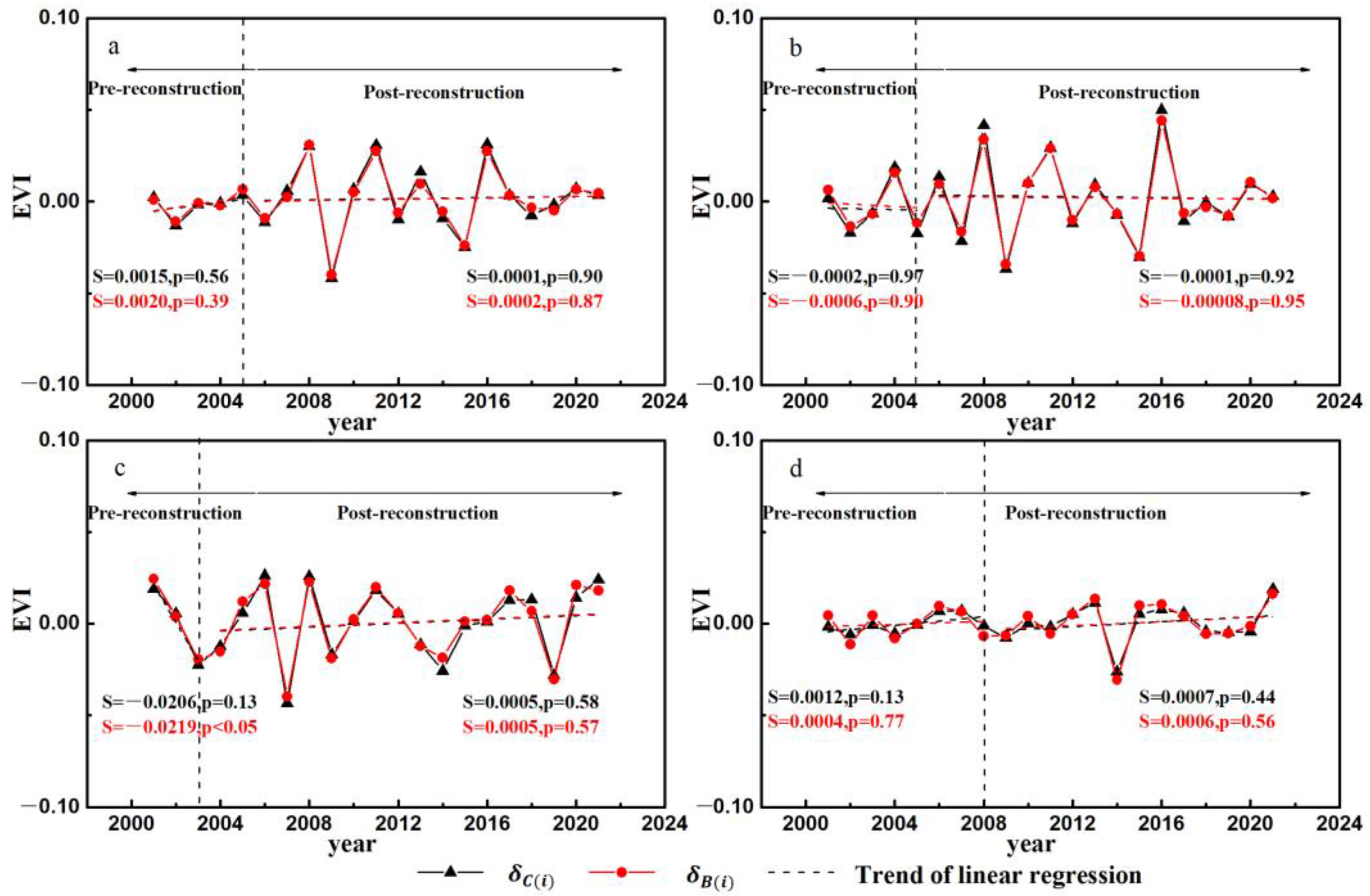
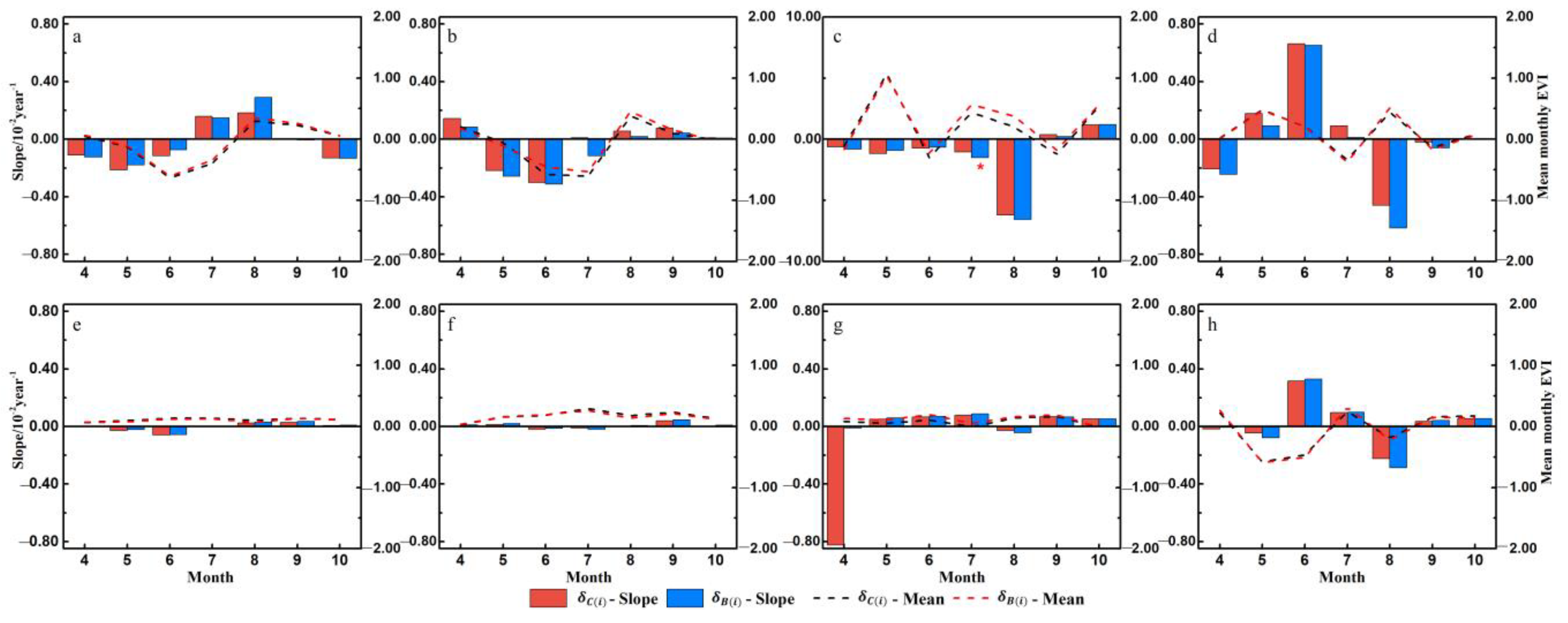

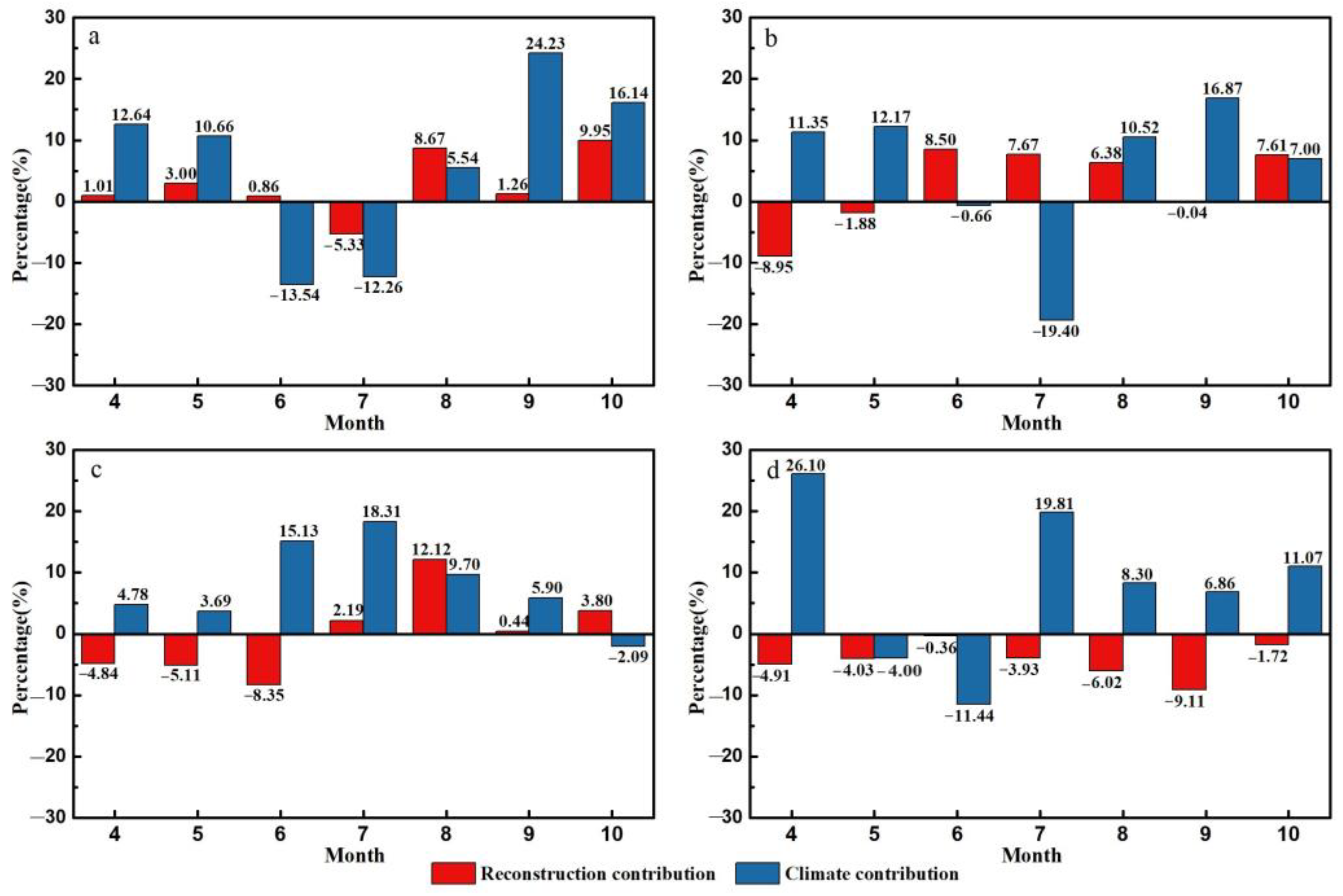

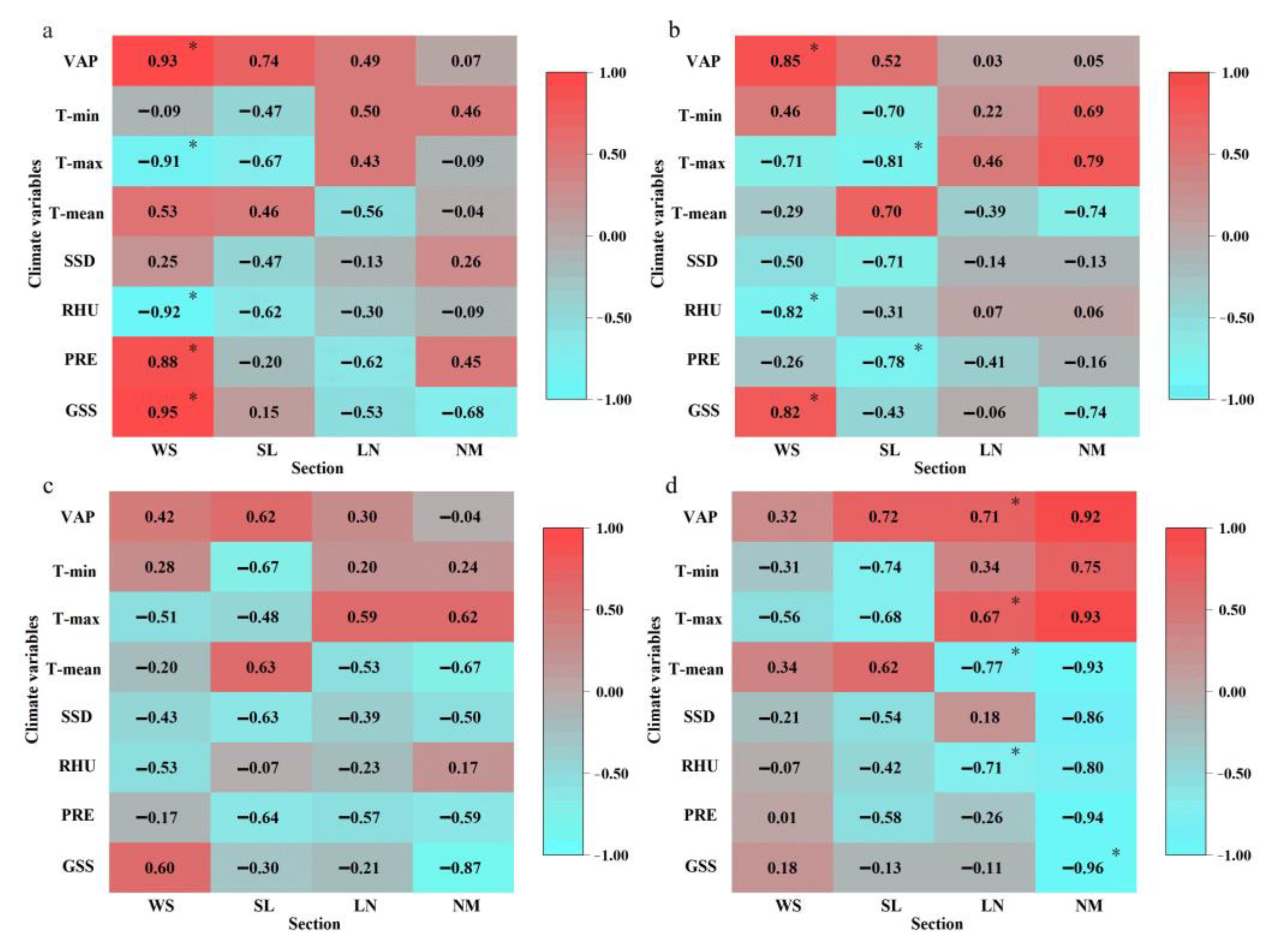
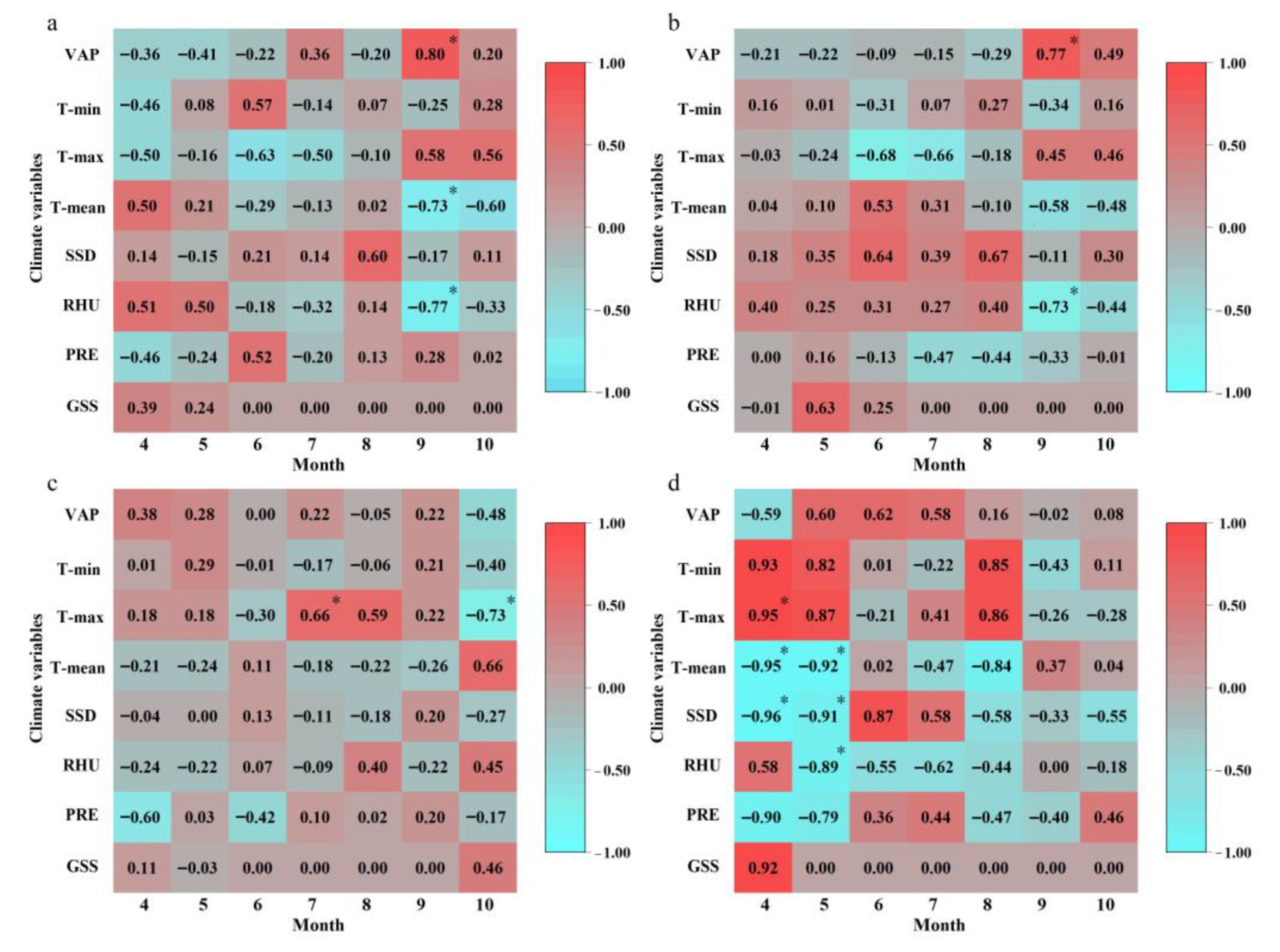
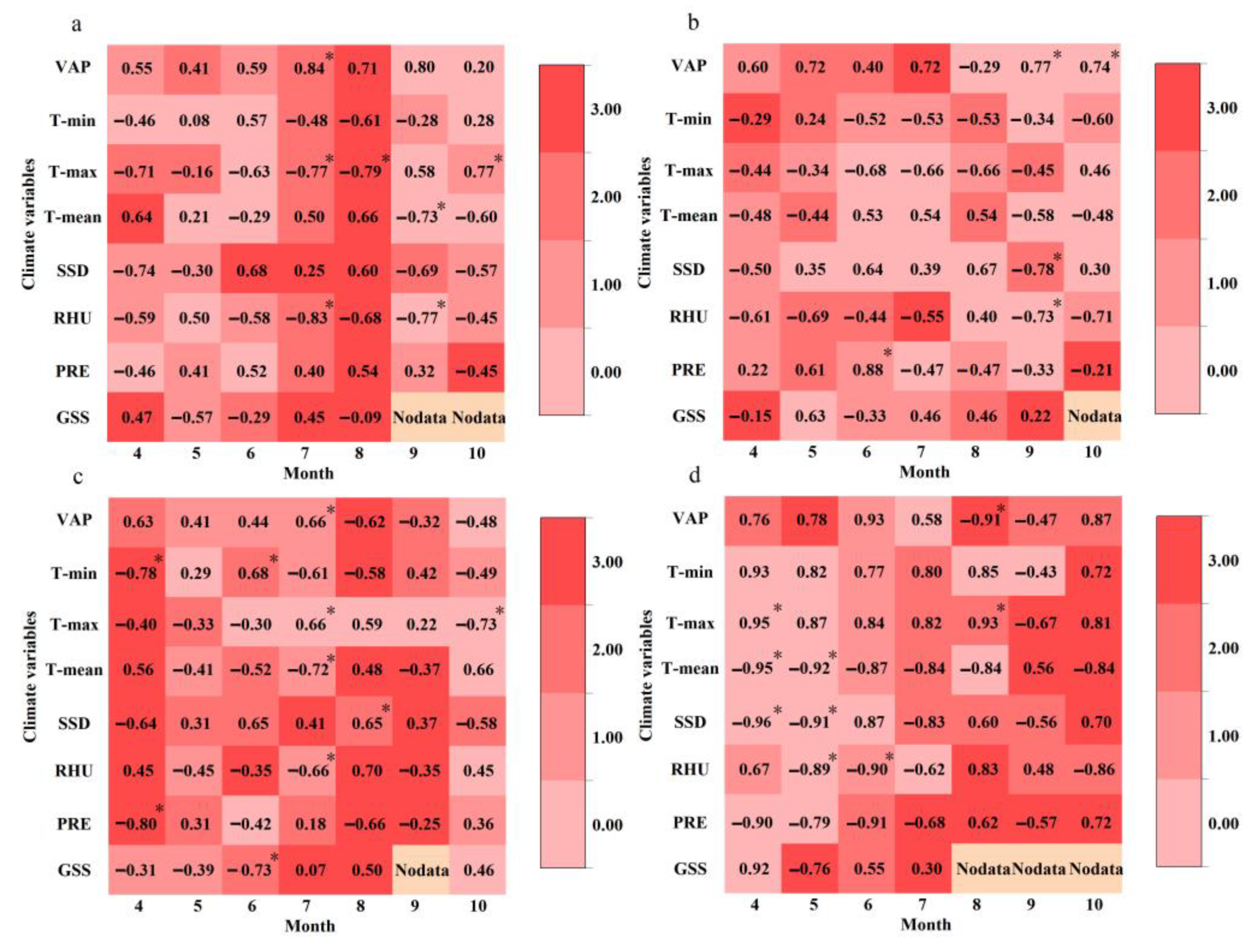
| Road Section | Length (km) | Pre-Reconstruction Period (a) | Post-Reconstruction Period (a) |
|---|---|---|---|
| West of Shigatse (WS) | 510 | 2000–2005 | 2006–2021 |
| Shigatse to Lhasa (SL) | 296 | 2000–2005 | 2006–2021 |
| Lhasa to Nyingchi (LN) | 430 | 2000–2003 | 2004–2021 |
| East of Nyingchi (NE) | 790 | 2000–2008 | 2009–2021 |
Disclaimer/Publisher’s Note: The statements, opinions and data contained in all publications are solely those of the individual author(s) and contributor(s) and not of MDPI and/or the editor(s). MDPI and/or the editor(s) disclaim responsibility for any injury to people or property resulting from any ideas, methods, instructions or products referred to in the content. |
© 2023 by the authors. Licensee MDPI, Basel, Switzerland. This article is an open access article distributed under the terms and conditions of the Creative Commons Attribution (CC BY) license (https://creativecommons.org/licenses/by/4.0/).
Share and Cite
Guo, L.; Li, Y.; Luo, Y.; Gao, J.; Zhang, H.; Zou, Y.; Wu, S. The Compound Effects of Highway Reconstruction and Climate Change on Vegetation Activity over the Qinghai Tibet Plateau: The G318 Highway as a Case Study. Remote Sens. 2023, 15, 5473. https://doi.org/10.3390/rs15235473
Guo L, Li Y, Luo Y, Gao J, Zhang H, Zou Y, Wu S. The Compound Effects of Highway Reconstruction and Climate Change on Vegetation Activity over the Qinghai Tibet Plateau: The G318 Highway as a Case Study. Remote Sensing. 2023; 15(23):5473. https://doi.org/10.3390/rs15235473
Chicago/Turabian StyleGuo, Linghui, Yao Li, Yuanyuan Luo, Jiangbo Gao, Hebing Zhang, Youfeng Zou, and Shaohong Wu. 2023. "The Compound Effects of Highway Reconstruction and Climate Change on Vegetation Activity over the Qinghai Tibet Plateau: The G318 Highway as a Case Study" Remote Sensing 15, no. 23: 5473. https://doi.org/10.3390/rs15235473
APA StyleGuo, L., Li, Y., Luo, Y., Gao, J., Zhang, H., Zou, Y., & Wu, S. (2023). The Compound Effects of Highway Reconstruction and Climate Change on Vegetation Activity over the Qinghai Tibet Plateau: The G318 Highway as a Case Study. Remote Sensing, 15(23), 5473. https://doi.org/10.3390/rs15235473








